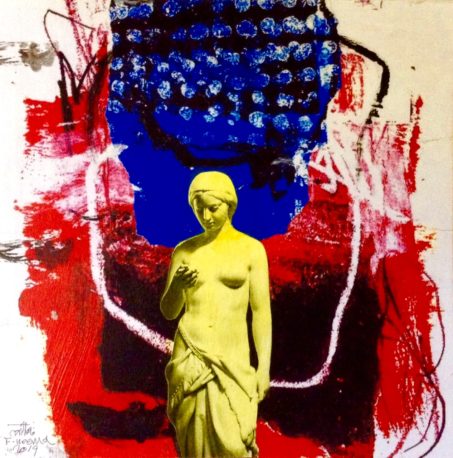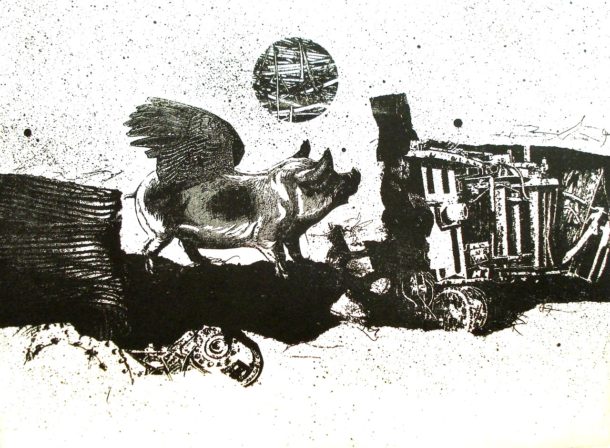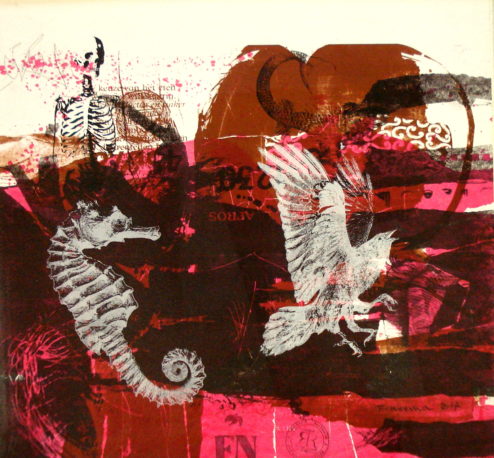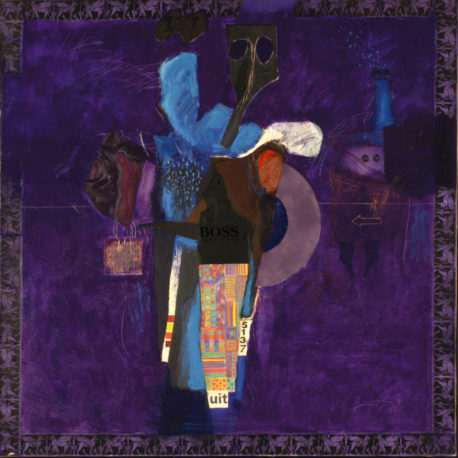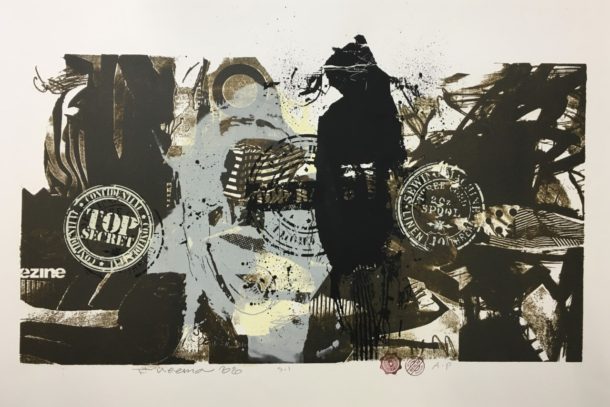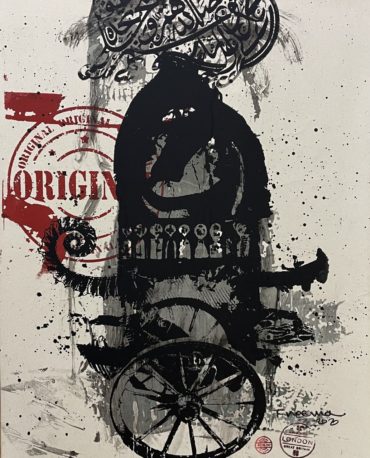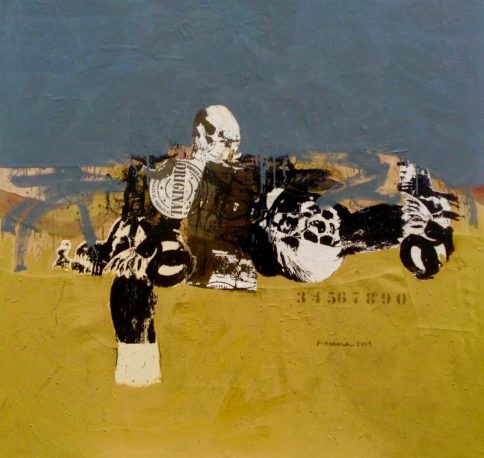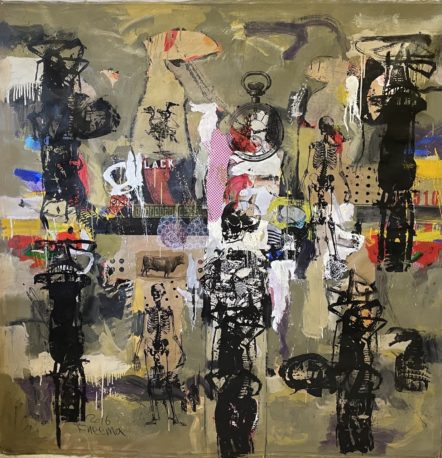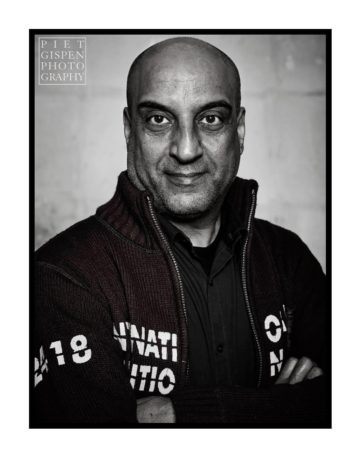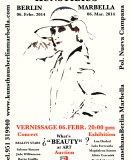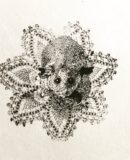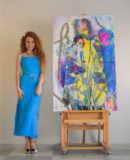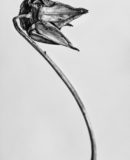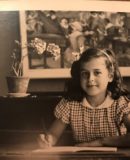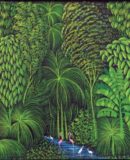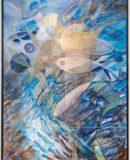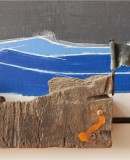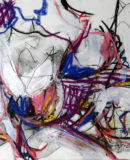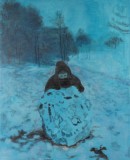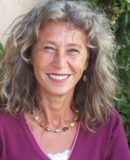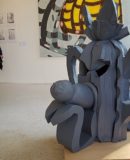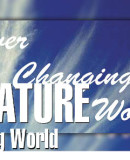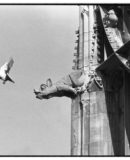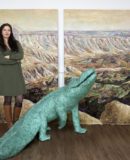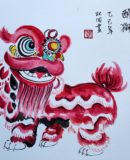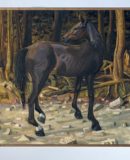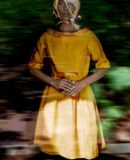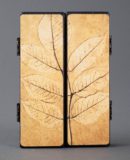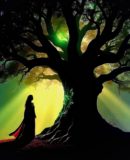World Fine Art Professionals and their Key-Pieces, 330 - Fathel Neema
World Fine Art Professionals and their Key-Pieces, 330 – Fathel Neema
In Pulchri I saw the exhibition ‘The sixth sense’ by Fathel Neema with large and smaller paintings in bright colours, graphics and linocuts. Some time later I visit the artist in his studio in an industrial zone in Rijswijk.
Fathel Neema’s studio is packed. There are an etching press and a screen printing press and dozens of large and smaller works against the walls and on shelves. On the table are black lino prints fresh off the press with the heads of Karl Marx and Samuel Beckett.
Intuition
Fathel Neema has been active as an artist in The Hague since 1998. He is originally from Kerbala, Iraq. He is highly productive, as evidenced by many solo and group exhibitions in which he has participated. Where does the title ‘The Sixth Sense’ come from?
In addition to hearing, seeing, smelling, tasting and feeling, the sixth sense is intuition. That intuition allows him to create his works, he says. “I do not prepare or plan my work, nor do I know when and how I will make a work. Something strongly drives me to do it! When I complete one of my canvases, I feel like I have lost a great deal of my suffering. I often wonder how I painted such a canvas or how I dealt with such an issue. It seems like I was in another universe or someone took my hand and told me what to do.”
The title ‘The sixth sense’ also refers to the viewers of his work. They can find comfort when they see art. Fathel: “Art is to comfort those who are broken by life, a quote by Vincent van Gogh.”
A painted story
Art is his way of thinking. “It’s what I see, think and feel. I paint in mixed media (collage), make etchings and linocuts. In the mixed-media work I use all kinds of materials and techniques together. Paper, fabric, cardboard, decorations and remnants of advertising paper and writings, which I process with oil paint. With that I make a painted story. I am used to going to my studio every day, this is my only concern, there is no distance between me and my work, I never went there without producing something.”
How would he describe his theme? Fathel: “You have artists with horses in their heads, such as Marino Marini. In my head there are no horses, but wars, books and documentaries about wars, politics and many difficult things in life.”
Stamps and numbers
Stamps and numbers can be seen in many of his works. “Stamps stand for evidence, stamps are in passports or important papers as proof that you really exist. I fled Iraq with a fake passport with fake stamps. The numbers also indicate something, the police enter a row of numbers and then they know everything about you, which is frightening.”
Fathel works in this studio from early in the morning until late at night, he says. “Every day of the week, except Sunday.” He came to this studio in 2016. “I was in Beirut for two years before that, from 2013 to mid-2016. I had a studio there with a woman. But it was not realistic to stay longer in Lebanon.”
The Academy of Baghdad
Fathel Neema graduated from both the Baghdad Academy and the Royal Academy of Art in The Hague. “In primary school I was always drawing and painting, even outside of school. I wasn’t going to play football, I was going to draw. The Academy of Baghdad taught me many techniques: etching, linocuts and woodcuts. The Academy lasted four years, but I stretched that to eight years so I wouldn’t have to go into the military to join the war.”
As soon as he graduated, he fled the country. He ended up in Austria via northern Iraq, Syria and Turkey. There he could stay for two years. Then he moved to the Netherlands. “The asylum seekers’ centers were full, mainly because of the wars in Afghanistan and Yugoslavia. It took a long time, three years, before I got a residence permit for the Netherlands.”
The Royal Academy
He was allowed to exhibit in one of the asylum seekers’ centers in Brunssum. The director provided him with the materials. While he was in another asylum seekers center in the west of the country, a Dutch friend arranged for him to go to the Royal Academy. “I went straight into the third grade. I was there all evenings, sometimes nights. “They were great people, the students, the teachers. Such as Simon Koene, Christie van der Haak and Tom Thijsse.”
He had two exhibitions at the Royal Academy: the first on the occasion of the graduation ceremony, and then a graphics exhibition. Subsequently there were exhibitions in Amman (Jordan), Vienna, the Wereldmuseum in Rotterdam, Museum Flehite in Amersfoort, Pulchri The Hague, City Hall The Hague, Doha (Qatar) and even in the Pergamon Museum in Berlin.
“On the top floors there is the Museum für Islamic Art. I was the first modern artist to be invited by the director to exhibit.”
The world revolves around money and power
Finally, what is his philosophy? Fathel Neema: “Art is everything to me, but art will not change the world. The world revolves around money and power. A painting, not even a poem or any other cultural medium, will be able to change a dictatorship or a repressive society. As much as I’d like to see it differently. ”
Images
1) beauty-40x40cm-mix, 2) Animal field-50x60cm-etching, 3) another world-70x70cm-screen, 4) pink blue canvas, 5) A scarecrow-50x60cm-lithi+screen,6) Death chariot-40x50cm-silkscreen, 7) From the memory-140x120cm-mixedmedia, 8) the big city-200x200cm-mixed media , 9) fathel neema2016 by Piet Gispen, 10) The mask-50x50cm-mixedmedia.
https://www.pulchri.nl/nl/tentoonstellingen/fathel-neema-het-zesde-zintuig/
https://ifthenisnow.eu/nl/verhalen/de-wereld-van-de-haagse-kunstenaar-108-fathel-neema
Disclaimer: The views, opinions and positions expressed within this guest article are those of the author Walter van Teeffelen alone and do not represent those of the Marbella Marbella website. The accuracy, completeness and validity of any statements made within this article are not guaranteed. We accept no liability for any errors, omissions or representations. The copyright of this content belongs to Walter van Teeffelen and any liability with regards to infringement of intellectual property rights remains with the author.

